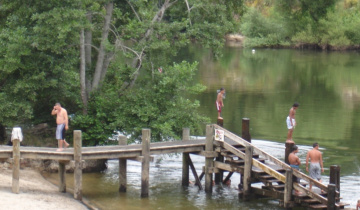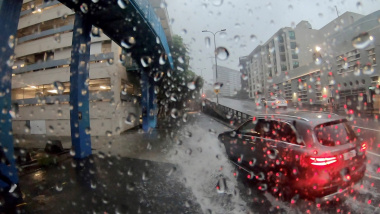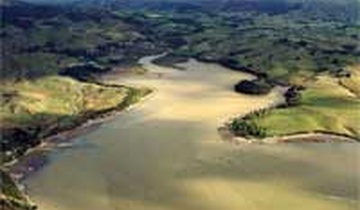Glass eels (about 5.5 to 7.0 cm) arrive in fresh water during spring, especially during September and October, although they may be present from July to December.
Glass eels arrive at the mouths of rivers in pulses, waiting for suitable conditions to enter. During the early part of the season, they tend to migrate into rivers on the incoming (flood) tide, especially on the spring tides of new and full moons. At this stage they show more attraction to salt water than to fresh water and mainly move at night. Later in the season, glass eels show more attraction to fresh water - this may show as a shift towards migrating during the outgoing tide.
Once they are in fresh water, glass eels take several days to adjust before they migrate further upstream. During this phase, glass eels become attracted to fresh water, show a strong tendency to swim against currents, and will often migrate during the day as well as the night. They frequently form very large schools, and at this stage they can be captured in large quantities as they migrate to the limits of the tidal reaches, where they congregate before continuing their upstream migration over successive summers as elvers.
Olfaction (or sense of smell) is highly developed in glass eels, and they are able to choose and respond to various water odours characteristic of their preferred habitats. As a result, glass eels are able to make specific choices about the type of river or stream to which they migrate; there may be different responses to different habitats for shortfin and longfin glass eels. Small eels seem to favour runs and riffles of waterways where the substrate is coarse and the current is swift.
Current evidence suggests that there has been a worldwide decline in recruitment of glass eels. Factors contributing to this decline are likely to include climate change, loss of habitat, parasite infestation, pollutants, over-fishing, and obstacles to migration.
References and further reading
August, S.M., Hicks, B.J. (2008). Water temperature and upstream migration of glass eels in New Zealand: implications of climate change. Environmental Biology of Fishes 81(2): 195-205. http://www.springerlink.com/content/gm2341440pr76581/
Chisnall, B.L., Jellyman, D.J., Bonnett, M.L., Sykes, J.R. (2002). Spatial and temporal variability in length of glass eels (Anguilla spp.) in New Zealand. New Zealand Journal of Marine and Freshwater Research 36: 89-104. http://www.royalsociety.org.nz/publications/journals/nzjm/2002/008/
Dekker, W. (2002). Monitoring of glass eel recruitment. Netherlands Institute of Fisheries Research Report C007/02-WD. Ijuiden, Netherlands. 256 p. http://www.rivo.wag-ur.nl/FTP_DIR/Biology_Ecology/Willem/Volume-1.pdf
Dekker, W. (2004). Slipping through our hands- Population dynamics of the European eel. PhD thesis. University of Amsterdam, The Netherlands. 186 p.
Feunteun, E. (2002). Management and restoration of European eel population (Anguilla anguilla): An impossible bargain. Ecological Engineering 18: 575-591. http://www.sciencedirect.com/science/article/pii/S0925857402000216
Jellyman, D.J. (1977). Invasion of a New Zealand freshwater stream by glass-eels of two Anguilla spp. New Zealand Journal of Marine and Freshwater Research 11: 193-209. http://www.royalsociety.org.nz/publications/journals/nzjm/1977/016/
Jellyman, D.J. (1979). Upstream migration of glass eels (Anguilla spp.) in the Waikato River. New Zealand Journal of Marine and Freshwater Research 13: 13-22. http://www.royalsociety.org.nz/publications/journals/nzjm/1979/002/
Jellyman, D., Lambert, P. (2003). The how and when of catching glass eels. Water & Atmosphere 11: 22-23. http://www.niwa.co.nz/news-and-publications/publications/all/wa/11-4/eels
Jellyman, D.J., Lambert, P.W. (2003). Factors affecting recruitment of glass eels into the Grey River, New Zealand. Journal of Fisheries Biology 63: 1067-1079. http://onlinelibrary.wiley.com/doi/10.1046/j.1095-8649.2003.00220.x/abstract
Jellyman, D.J., Ryan, C.M. (1983). Seasonal migration of elvers (Anguilla spp.) into Lake Pounui, New Zealand, 1974-1978. New Zealand Journal of Marine and Freshwater Research 17: 1-15. http://www.royalsociety.org.nz/publications/journals/nzjm/1983/001/
Jellyman, D.J., Todd, P.R. (1982). New Zealand freshwater eels: their biology and fishery. Information Leaflet 11. New Zealand Ministry of Fisheries, Fisheries Research Division. 22 p.
Jellyman, D. J., Booker, D.J, Watene, E (2009). Recruitment of Anguilla spp. glass eels in the Waikato River, New Zealand. Evidence of declining migrations? Journal of Fish Biology 74(9): 2014-2033. http://onlinelibrary.wiley.com/doi/10.1111/j.1095-8649.2009.02241.x/full
Jellyman, D.J., Chisnall, B.L., Bonnet, M.L., Sykes, J.R.E. (1999). Seasonal arrival patterns of juvenile freshwater eels (Anguilla spp.) in New Zealand. New Zealand Journal of Marine and Freshwater Research 33: 249-261. http://www.royalsociety.org.nz/publications/journals/nzjm/1999/022/
Jellyman, D.J., Chisnall, B.L., Sykes, J.R.E., Bonnett, M.L. (2002). Variability in spatial and temporal abundance of glass eels (Anguilla spp.) in New Zealand waterways. New Zealand Journal of Marine and Freshwater Research 36: 511-517. http://www.royalsociety.org.nz/publications/journals/nzjm/2002/041/
McCleave, J.D., Jellyman, D.J. (2002). Discrimination of New Zealand stream waters by glass eels of Anguilla australis and Anguilla dieffenbachii. Journal of Fish Biology 61: 785-800. http://onlinelibrary.wiley.com/doi/10.1111/j.1095-8649.2002.tb00911.x/abstract












